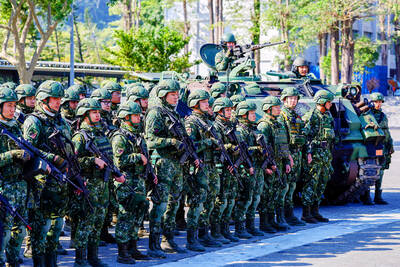Chinese Nationalist Party (KMT) Legislator Chiang Wan-an (蔣萬安) yesterday reaffirmed his opposition to China’s “one country, two systems” formula after his previous support for President Tsai Ing-wen’s (蔡英文) “four musts” drew ire from pan-blue supporters.
Chiang, grandson of former president Chiang Ching-kuo (蔣經國), first expressed opposition to the “one country, two systems” formula during a political talk show on Thursday last week, in which he also expressed support for Tsai’s “four musts” as a basis for cross-strait relations.
Tsai in her New Year’s Day speech on Tuesday last week said that China must recognize the existence of the Republic of China (ROC); respect the values of democracy and freedom that Taiwan’s 23 million residents hold dear; resolve cross-strait differences in a peaceful and equitable manner; and engage in negotiations with the government or an institution with a mandate from the government.

Photo: George Tsorng, Taipei Times
Chiang Wan-an’s support for Tsai’s position on cross-strait ties drew criticism from KMT supporters, with many attacking him on Facebook and some calling him a “separatist.”
A KMT member praising Tsai’s speech “is classic inexperience and naivety,” former KMT Central Policy Committee director Alex Tsai (蔡正元) said.
“When did Tsai Ing-wen and the Democratic Progressive Party (DPP) ever acknowledge the existence of the ROC? Does [Beijing] require the abolition of freedom and democratic systems [as part of unification]?” he asked.
The so-called “1992 consensus” is a peaceful way for Taiwan to achieve parity with China, Alex Tsai said.
The “1992 consensus,” a term former Mainland Affairs Council chairman Su Chi (蘇起) in 2006 admitted making up in 2000, refers to a tacit understanding between the KMT and the Chinese Communist Party that both sides of the Taiwan Strait acknowledge there is “one China,” with each side having its own interpretation of what “China” means.
Chiang Wan-an yesterday said that he supports the KMT’s definition of the “1992 consensus” that both sides of the Strait must be free to define “China” in their own way.
That freedom forms the basis of the “1992 consensus,” which is built on the foundation of the ROC Constitution and is executed through the Act Governing Relations Between the People of the Taiwan Area and the Mainland Area (台灣地區與大陸地區人民關係條例), he said.
While he does not agree with Tsai Ing-wen’s refusal to acknowledge the “1992 consensus,” he could not accept the “one country, two systems” formula, Chiang said.
“Taiwan is not Hong Kong,” he said, adding that most Taiwanese would not accept unification under the formula.
Whoever is president needs to follow the nation’s Constitution and protect its sovereignty, he said.
He added that regardless of who is president, they must acknowledge the existence of the ROC, protect democracy and the freedom of its citizens, and must resolve differences with China in a way that recognizes the equal legitimacy of the ROC and its institutions.
“If President Tsai refuses to accept the ‘1992 consensus’ and refuses to acknowledge its existence, I implore her to provide a specific solution for discourse with China, and not just throw around hipster slogans,” Chiang Wan-an said.

UNILATERAL MOVES: Officials have raised concerns that Beijing could try to exert economic control over Kinmen in a key development plan next year The Civil Aviation Administration (CAA) yesterday said that China has so far failed to provide any information about a new airport expected to open next year that is less than 10km from a Taiwanese airport, raising flight safety concerns. Xiamen Xiangan International Airport is only about 3km at its closest point from the islands in Kinmen County — the scene of on-off fighting during the Cold War — and construction work can be seen and heard clearly from the Taiwan side. In a written statement sent to Reuters, the CAA said that airports close to each other need detailed advanced

Tropical Storm Fung-Wong would likely strengthen into a typhoon later today as it continues moving westward across the Pacific before heading in Taiwan’s direction next week, the Central Weather Administration (CWA) said. As of 8am, Fung-Wong was about 2,190km east-southeast of Cape Oluanpi (鵝鑾鼻), Taiwan’s southernmost point, moving westward at 25kph and possibly accelerating to 31kph, CWA data showed. The tropical storm is currently over waters east of the Philippines and still far from Taiwan, CWA forecaster Tseng Chao-cheng (曾昭誠) said, adding that it could likely strengthen into a typhoon later in the day. It is forecast to reach the South China Sea

Almost a quarter of volunteer soldiers who signed up from 2021 to last year have sought early discharge, the Legislative Yuan’s Budget Center said in a report. The report said that 12,884 of 52,674 people who volunteered in the period had sought an early exit from the military, returning NT$895.96 million (US$28.86 million) to the government. In 2021, there was a 105.34 percent rise in the volunteer recruitment rate, but the number has steadily declined since then, missing recruitment targets, the Chinese-language United Daily News said, citing the report. In 2021, only 521 volunteers dropped out of the military, the report said, citing

WEATHER Typhoon forming: CWA A tropical depression is expected to form into a typhoon as early as today, the Central Weather Administration (CWA) said yesterday, adding that the storm’s path remains uncertain. Before the weekend, it would move toward the Philippines, the agency said. Some time around Monday next week, it might reach a turning point, either veering north toward waters east of Taiwan or continuing westward across the Philippines, the CWA said. Meanwhile, the eye of Typhoon Kalmaegi was 1,310km south-southeast of Oluanpi (鵝鑾鼻), Taiwan’s southernmost point, as of 2am yesterday, it said. The storm is forecast to move through central